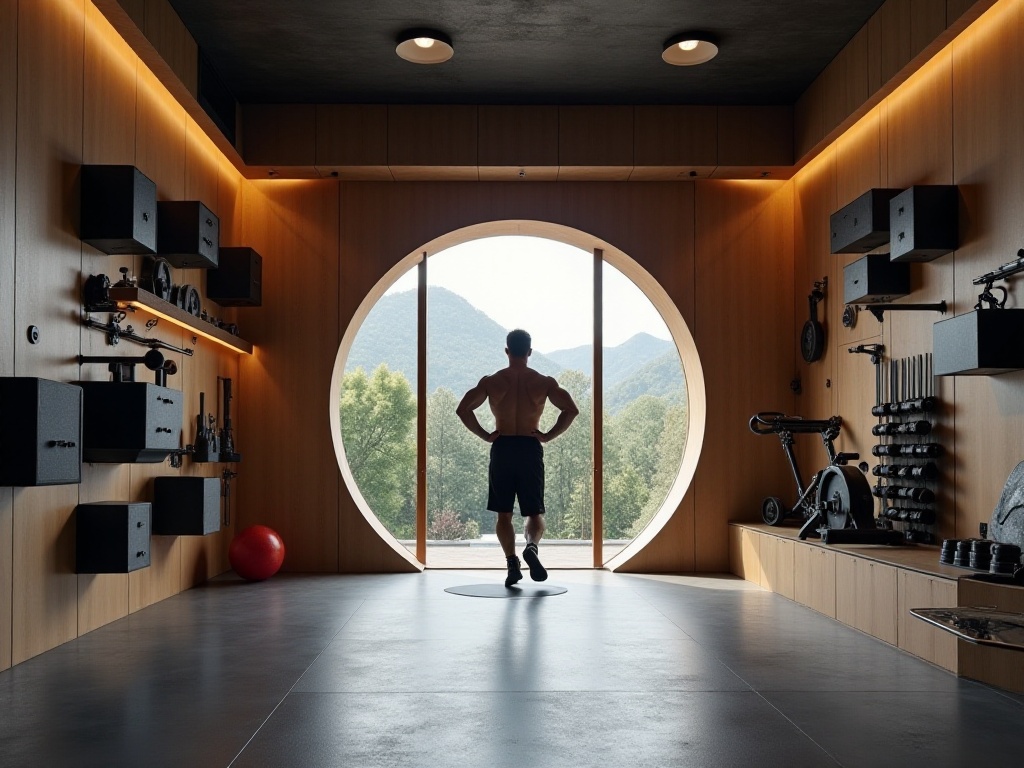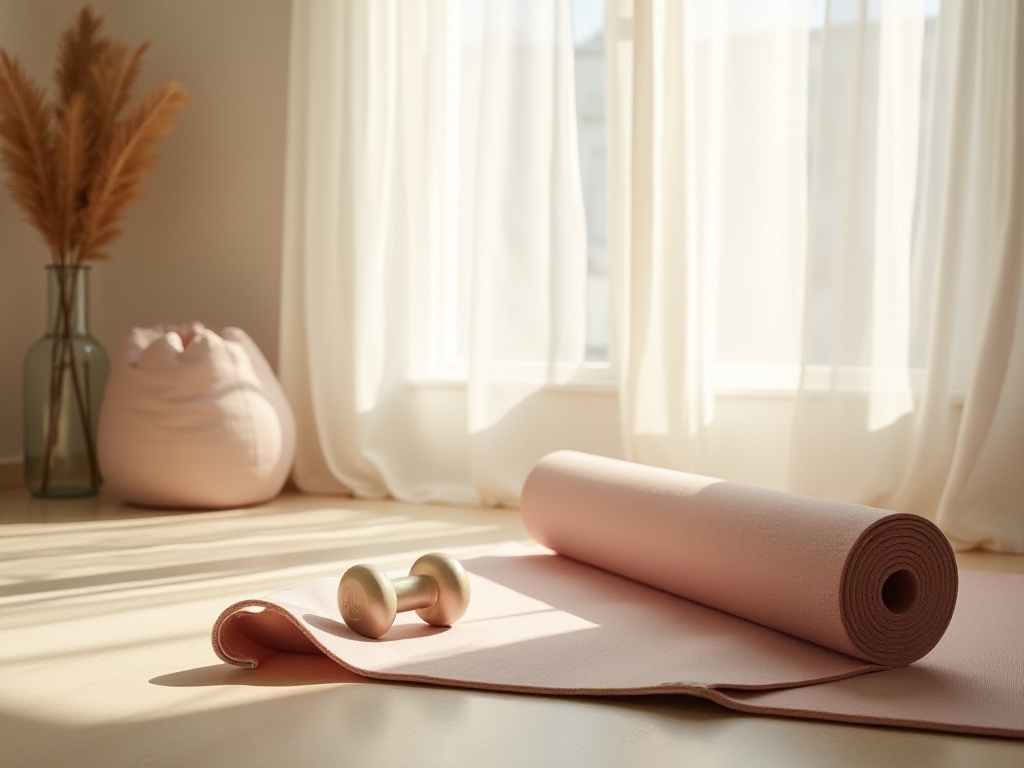Introduction
A few days ago, I posted a fitness photo on social media, and many people in the comments asked which gym I work out at. When I said it was at home, everyone was amazed. As someone who transformed from working out in a tiny space to becoming a fitness enthusiast, I deeply understand that many people struggle to find suitable workout spaces. Today I'll share my home workout insights from the past three years and teach you how to transform your small space into a professional fitness area.
Space Setup
Honestly, I initially thought my home was too small for working out. Then one day, I saw my neighbor's workout corner on their balcony and had an epiphany: space wasn't the problem, mindset was.
After much research and experimentation, I finally created a perfect workout corner at home. Specifically, I have a well-lit spot next to my balcony, about two square meters in size. I bought a non-slip, sweat-absorbent yoga mat to lay on the floor. Then I installed a full-length mirror on the wall, which helps me check my form and makes the space feel more open.
I also designed a simple storage system to keep all my workout equipment neat and organized. For example, resistance bands hang on wall hooks, and the yoga mat stands against the wall - everything is easily accessible but can be quickly put away without taking up space.
Notably, I discovered that working out in open spaces like the living room or balcony is much more effective than in the bedroom. Psychologically, our brains associate bedrooms with rest. Whenever I enter my bedroom, I instinctively want to lie down and scroll on my phone. But exercising in the living room or balcony puts me in a completely different mental state and feels particularly energizing.
To enhance the workout atmosphere, I put up several motivational posters on the wall with my fitness goals and encouraging messages. Seeing these slogans daily helps boost my motivation. I also placed a small fan in the corner to improve air circulation during workouts, which feels particularly refreshing.

Equipment Selection
When it comes to equipment selection, I have plenty of money-saving tips to share. When I first started working out, I really started from scratch, not wanting to spend any extra money.
Back then, I searched through my home and found two 1.5-liter water bottles, filled them with water, and they became my first dumbbells. Honestly, this weight was perfect for beginners. Later, to increase training intensity, I tried using a backpack filled with books for weight training. I remember once stuffing several thick books into the bag - I nearly collapsed, but the training effect was really good.
As my fitness level improved, I gradually started acquiring some basic equipment. The first thing I bought was a resistance band with adjustable tension for 40 yuan. This little tool was totally worth it - it's great for arms, legs, and stretching, making it a perfect home workout essential.
Then I bought a professional yoga mat. My previous floor mat would get slippery during workouts, and being too thin, my knees would hurt during kneeling exercises. The new yoga mat is non-slip on both sides with suitable thickness, cost 120 yuan, and is such good quality that it still looks new after more than a year of use.
For timing, I just use my phone. However, I recommend downloading a specialized workout timer app, as regular timers are too basic and can't set rest periods between sets or provide voice prompts. The app I use also tracks daily workout data, helping me better plan my training.
Later, I gradually added some small equipment like foam rollers, yoga blocks, and small dumbbells. These items aren't expensive but greatly diversify training options. My advice is not to buy too much at once, but add equipment gradually based on your progress and actual needs.

Time Management
On the topic of time management, I really relate. When I first started working, I was overwhelmed with meetings and deadlines, feeling like I never had time to exercise. It wasn't until I seriously analyzed my schedule that I realized I was wasting time on various fragmented activities.
Later, I set a strict rule: start exercising at 7 AM every day, rain or shine. Why 7 AM? Research shows that morning exercise not only boosts metabolism but keeps you in a good mood all day. Plus, at that time, family members are still asleep, so it's particularly quiet with no interruptions.
My current schedule is like this: Wake up at 6:40, drink half a glass of warm water, quickly freshen up, and change into workout clothes. At 6:55, I start some simple warm-up activities, and at 7:00, formal training begins. I plan the training content the night before, so I don't have to think about what to practice in the morning.
I usually divide the 30-minute training time into three parts: 5 minutes of warm-up, 20 minutes of main training content, and 5 minutes of cool-down. This time allocation ensures training effectiveness without being too exhausting.
Sometimes when work is particularly busy and I can't wake up early, I'll switch to evening workouts. However, I've found that evening workout completion rates aren't as high as morning ones, often disrupted by overtime work or social engagements. So now I try to stick to morning workouts, and even in special circumstances, I ensure at least 15 minutes of basic training.

Gradual Progress
Speaking of gradual progress, I really have deep feelings about this. I remember when I first started working out, I saw those expert training videos online and wanted to train that intensely myself. As a result, I did 50 push-ups on the first day, and the next day my arms were so sore I could barely hold a toothbrush - I almost gave up.
Later I understood that you really can't rush exercise progress. I made a new progressive training plan, starting with the most basic movements. The first week focused on mastering correct form, practicing just a few basic movements each day, like standard squats and planks. Though they seem simple, doing them correctly isn't easy.
By the second week, I gradually increased the volume and difficulty of training. For example, squats increased from 10 reps per set to 15; planks extended from 30 seconds to 45 seconds. Each time I increased training volume, I paid special attention to my body's response, maintaining the original training volume for several more days if it felt too challenging.
Starting the third week, I added some advanced movements like lunges and modified push-ups. By then, I was quite familiar with the basic movements, and my body had adapted to the exercise intensity, making new movements less challenging.
Looking back now, this progressive approach was really scientific. It not only helped me avoid exercise injuries but also helped establish correct exercise habits. Moreover, as training deepened, I increasingly felt physical changes, and the sense of achievement from this progress was really great.
Maintaining Motivation
Honestly, maintaining exercise motivation is the hardest part. I found the most effective method is setting small goals for yourself and recording specific data.
I bought a beautiful notebook specifically for recording daily training content, time, sets, as well as physical condition and feelings. This has two benefits: one is clearly seeing your progress, and two is finding motivation when looking back at previous records on days when you feel lazy.
Besides recording, I also designed a reward system for myself. After each workout, I record it on my phone like saving money. The rules are: 10 yuan for regular training, 20 yuan for high-intensity training, and an extra 50 yuan bonus for working out continuously for a week. When I save up to 500 yuan, I reward myself with a piece of workout equipment or a professional personal training session.
This method is particularly interesting because it turns monotonous exercise into a savings game. Plus, workout equipment purchased this way gives me a special sense of achievement, making me more invested when training with it.
I also found that sharing exercise experiences with others is a good way to maintain motivation. I post my workout videos or photos on social media and exchange insights with other fitness enthusiasts. Sometimes receiving encouragement and suggestions from netizens makes me really happy, feeling like I'm not fighting alone.

Creating Atmosphere
The importance of workout atmosphere cannot be overstated. Now I have a fixed "ritual" before each workout: changing into dedicated workout clothes, tying up my hair, spraying some refreshing perfume. These small details may seem ordinary, but they help me quickly get into workout mode.
Music selection is also crucial. I've created several specialized playlists for different training content. For strength training, I like listening to energetic electronic music; for yoga, I switch to soothing light music. The rhythm of music not only helps control exercise speed but makes the entire training process more enjoyable.
Additionally, I pay attention to room lighting and temperature. I found exercising in natural light improves mood, so I open the curtains for morning workouts to let sunlight in. For temperature, I usually set the air conditioning to 24 degrees Celsius, which is neither too hot nor too cold for exercise.
Sometimes I also light aromatherapy candles, as the subtle fragrance can help relax. However, it's important to choose fresher scents, as overly strong fragrances can affect breathing.

Habit Formation
After three years of exploration, I've summarized an effective set of habit-forming methods. First is integrating exercise into daily life, not treating it as something special.
For example, I do simple stretches while watching TV. During long periods of sitting at work, I get up every hour for five minutes of activity, whether it's a few squats or simple walking. This way, it doesn't feel like deliberately making time for exercise, yet maintains body vitality.
I've also developed a habit of being mindful of my standing and sitting posture at all times. Correct posture not only prevents neck and spine problems but improves body shape with long-term persistence. Now I unconsciously keep my chest up and abdomen in while walking, and maintain natural spine curvature while sitting.
Additionally, I think the most important aspect of cultivating exercise habits is patience. Don't expect immediate results, but enjoy the process of change that exercise brings. It's like growing flowers - only with daily watering and fertilizing will they gradually grow and bloom.
Conclusion
Looking back at these three years of home workouts, I'm really grateful to my past self who was determined to change. Although there were moments of confusion and difficulty, each instance of persistence brought me one step closer to my goal.
Fitness hasn't just changed my physique; more importantly, it's changed my lifestyle and mindset. I'm now more confident and energetic in everything I do. So I want to tell everyone who wants to start exercising: don't make excuses, start acting now!
Let's transform our homes into the most comfortable gyms and begin a new chapter of healthy living. I look forward to seeing your stories and experiences shared in the comments!




